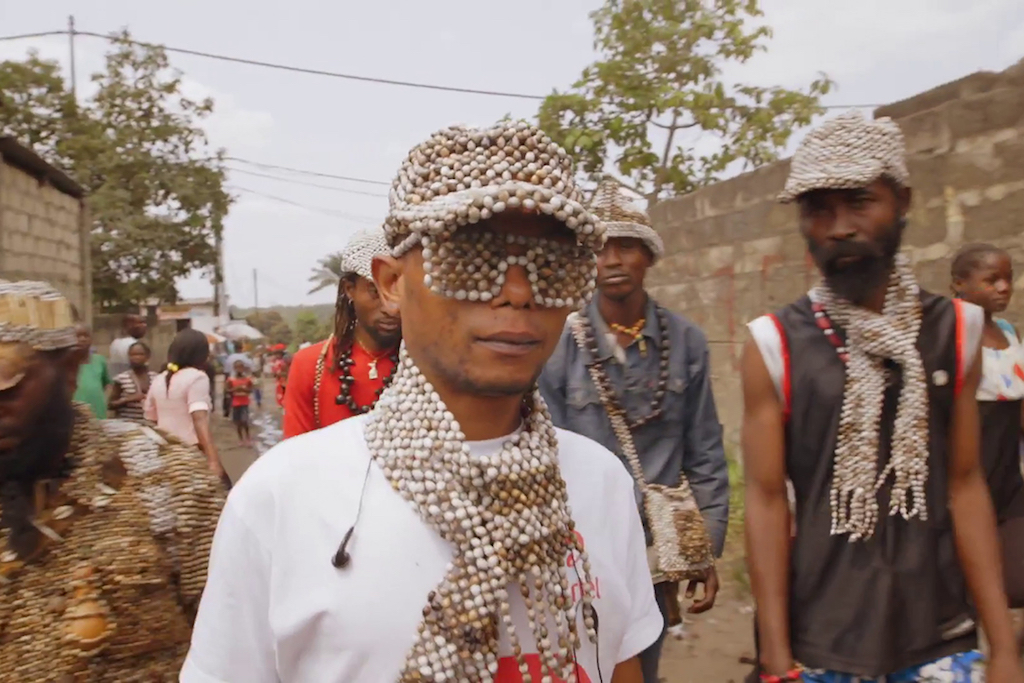Congo’s Dapper Fashion Scene Will Change The Way You Think About Clothing
"The streets of Kinshasa are the runways."


Watch States of Undress now on SBS On Demand, where former model Hailey Gates explores global fashion & issues the industry often ignores, showing us what the world wears & why.
“This is wild,” says Hailey Gates, host of Viceland’s new series States Of Undress. The show contemplates fashion as a litmus test of a country’s social climate, and she’s in the middle of a street in Kinshasa (capital of the Democratic Republic of the Congo) surrounded by a cheering crowd. They’re not there for her. They’re fans of the man by her side, Kadhitoza, who is “king” of local style community The Sapeurs. He’s often called the “boss of fashion”.
“It’s like being with a Beatle!” says Gates.
It’s easy to think of fashion as something that happens on runways in Paris and New York, or as part of the fast fashion mega-industry, but it’s here on the streets that style is at its most socially revealing. While States Of Undress takes a world tour of lesser-known fashion weeks, the majority of airtime explores the tensions and joys of everyday fashion, where style moves beyond simply ‘what we wear to survive’ to an expression of identity, community, and innovation.
Often government-funded, fashion weeks are meant for an international audience; they’re about how you want the world to see you. The streets are how you see yourself. Driven by motivations other than profit, indie designers and communities are hot beds of experimentation and resourcefulness.
Here are some of the communities profiled by Gates in States of Undress:
The Runways Of Kinshasa
To be stylish in the Democratic Republic of the Congo is to be a Sapeur, an extravagant dandy of the sub-Saharan region. The movement began at the end of the 19th Century during the period of brutal colonisation by the Belgian and French, when European clothing was used as payment in lieu of money.
Congolese men adopted the clothing with such enthusiasm it “became an act of defiance against their subjugation”. The modern movement continues the tradition, with a mix of European labels teamed with local designs, prints, and ideas of style (and loads of swagger). La Sape also provides locals with jobs, and has grown offshoots like the ‘eco-sapeurs’ who make clothing from 100 percent natural materials.
In a country where more than half of the population lives on less than a dollar a day, where violence and human rights issues continue, fashion might seem trivial. But it’s really a way to help cope with a society torn apart by war.
“Getting dressed and walking around is an activity here; the streets of Kinshasa are the runways,” Gates says. “The street fashion and the commitment to dressing up, even in the midst of volatility, has the power to transform these streets into a point of national pride.”
(Featured in season 1, episode 6)
Tackling Censorship In China
China is the world’s largest manufacturing power, producing an astonishing 65 percent of the world’s clothing. ‘Mass production’ and China may be synonymous, but the landscape is changing. Faced with a slowing economy, the factory model is being transformed under the government’s Made in China 2025 initiative, where emphasis is shifting from a nation of manufacturers to a nation of creators exporting local ideas and designs. But it’s a complex climate for designers, with a precedent of outspoken artists having issues with the government, as well as ever-present censorship.
Internet censorship in China is widely considered to be the most extreme in the world, but this isn’t stopping designer Wang Shou-ying. The small town 25-year-old gained celebrity status when she posted photos of her DIY creations on Chinese social media site Sina Weibo. The self-described “fairy” is known for her unconventional creations that use materials like trash bags, food, and packaging.
Then there’s Beijing artist Kong Ning, who uses fashion to make statements about the environment in this precarious context. An ex-criminal defence lawyer, Kong uses over-the-top creations to put the spotlight on environmental issues. Featuring hundreds of eggs and facemasks, Kong’s dresses draw attention to issues like air pollution, which is estimated to kill an estimated 4,000 people in China a day.
(Featured in season 1, episode 6)
Palestine’s First Lingerie Company
What would you do for a cute bra? This is a question few of us have to consider in Australia, but for Palestine’s first lingerie company, it’s a serious consideration. Given conflict, restrictions on freedom of movement, high import taxes, and a complicated postal service, the founders of Ramallah-based Kenz face a battle to make the simple act of buying nice underwear easier for Middle Eastern women.
Christina Ganim and Nicola Isabel launched Kenz after experiencing the frustrations of buying lingerie in the West Bank where it’s almost impossible to go into a store and find something that fits. Women either face slow, expensive and unreliable imports by shipping high-end labels to a friend in nearby Jerusalem or Amman, or rely on local markets with limited, sometimes smuggled goods and awkward experiences with the older men who run the stalls.
While the Kenz founders face daily challenges, including travel restrictions and the logistics of running distribution from a warehouse space in Dubai, it’s a challenge they’re more than ready to face to bring high-end undies to Middle Eastern women through a discreet online store.
(Featured in season 1, episode 5)
–
Lana Guineay is a writer, editor, coffee drinker. She’s sometimes known to be Friggen Awesome.
–
To learn more about Hailey Gates’ journey into the fascinating world of global fashion, head to the States Of Undress page on SBS On Demand.